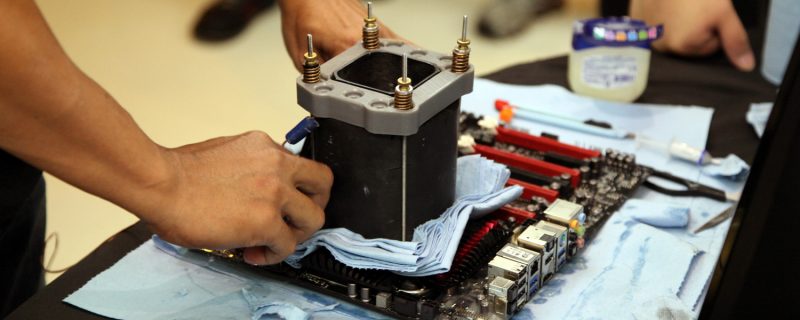
Popular image of extreme PC cooling is the use of liquid nitrogen. But this is not the only way to cool your hardware below ambient temperature. Moreover, there are many misconceptions about the liquid nitrogen itself. Allow me to introduce you to the world of chips cooled to subzero temperatures.
Coldbug
I will begin by explaining a term I’ll be referencing throughout this article– coldbug. Some hardware is capable of proper operation even at -250 degrees Celsius. But a lot of gear just switches off at a certain negative temperature. It could be -20 degrees or -130 degrees— it depends on the architecture, among many other factors. The exact temperature at which the CPU or GPU switches off is called the coldbug.
Part One: Liquid Nitrogen
In my opinion the best solution for extreme cooling, I’ll refer to it as nitrogen or LN2.
It is -197 degrees Celsius, which is really cold and enough to max out most hardware. It is relatively cheap, though there is one catch: It has to be stored in special containers called Dewars (from Dewar flask), which—you guessed it—cost a bundle. Dewars are basically very big vacuum flasks made of metal and there are two types.
- The most popular of the two, not tightly sealed – the nitrogen stored in them has atmospheric pressure, and LN2 is poured out of and into them gravitationally. You can find smaller and bigger models, but for ease of handling (both size- and weight-wise) I wouldn’t recommend anything bigger than a 30-liter capacity.
The Cap visible at the bottom of the picture doesn’t seal the Dewar tightly
Pressure tanks, which are much more expensive. LN2 is poured out of them through a special lance. Meanwhile, if the pressure inside gets too high, it is vented by a security valve. Even the smallest containers of this type are so big and heavy that one person is incapable of lifting them and they don’t fit into a standard car.
My supplier pouring LN2 from a stationary pressurized Dewar into a standard Dewar
Good to know: The “Smoke” that appears when using LN2 is just steam.
To utilize nitrogen as a PC coolant, special containers, commonly called pots, are used, and can be mounted on a CPU, GPU, RAM or North Bridge to pour LN2 inside of it. Most commonly, the base is made of copper and the top of aluminum. But producing a good pot isn’t as simple as you’d think—it has to be designed properly. To maximize heat exchange, the base should have its surface extended by drilling, while to reduce thermal inertia, it should have a substantial mass.
A cross-section of a CPU container
RAM container
Different types of hardware call for different types of containers to be used.
Some CPU pots are manufactured to maintain as stable a temperature as possible (for hardware with coldbugs) while others focus on a quick temperature drop to save LN2 (for hardware without coldbugs).
For GPUs, there are fat pots that offer stable temperatures, but because of their size, they are unfit for multi-GPU usage. On the other hand, there are slim pots that sacrifice temperature stability for the possibility of assembling a multi-GPU setup.
GPU slim container
GPU fat container
When using liquid nitrogen, it is easy to control the temperature of the hardware being cooled. It just depends on the amount of nitrogen poured and the quality of the pot used.
One liter of liquid nitrogen converts to seven hundred liters of gas nitrogen after evaporation. Yes, that is a 1:700 ratio. This means two important things:
- While using nitrogen indoors you must keep the window(s) open. If you don’t, the nitrogen will eventually push all of the oxygen out of the room, causing all living creatures to lose consciousness and suffocate.
You may find it interesting that because of its expansiveness when moving to its gas state, LN2 could be used to extinguish fires in mines – combustion stops without oxygen (more about it here).
- You can’t put LN2 into tightly closed vessels. After some time they will explode from built-up pressure. Therefore, forget about transporting nitrogen in a closed vacuum flask.
Contrary to popular belief, wearing gloves while handling extremely cold liquids is completely unnecessary. If you pour LN2 on your skin it just slides over the air cushion without actually touching the skin. It is the same as pouring a drop of water on a hot frying pan. The drop will appear to dance as it hovers over the air cushion. This is called the Leidenfrost Effect. However, if you were to put your hand into nitrogen or hold LN2 in your hands for a longer time, you won’t soon forget the burns you’ll come away with—just as if you touched something very hot.
As for the gloves, they are not, in fact, such a hot idea. If you pour LN2 on cloth gloves it would soak through and burn you badly. Even if you’re using rubber gloves, you could still spill LN2 inside of them. As you see, bare hands are much better.
LN2 briefly contacting the skin is totally harmless; please note that gloves used here have purpose of preventing frostbite from holding extremely cold metal
Please note: Protective glasses are advisable, especially for less experienced users. If you choose not to wear them, it is entirely your responsibility.
Warning: Please don’t pour LN2 into thermal flasks with a glass insert. They aren’t produced with such big thermal differences in mind and the glass part could explode, creating a deadly geyser of tiny glass shrapnel.
Due to the high temperature differences (delta) between the pot and air, the dew point is hit, causing condensation to take place.
Pouring LN2 into a CPU container without insulation
To prevent condensed water from destroying your hardware, special countermeasures must be taken. Although there isn’t one proper school of insulation, every overclocker has his or her own tricks and solutions. Materials usually used to insulate a PC are:
- Artistic eraser
- Vaseline
- Paper towels
- Armaflex
- Liquid plastic
- Liquid rubber (Plasti Dip)
PC during preparations for extreme cooling; vaseline in the background and brush for applying it, in the foreground
Hoarfrost at the top of CPU pot after few hours of OC
Here is a summary of the good and the bad when it comes to using LN2:
The upsides:
- It’s Relatively easy to obtain
- An easy mean to achieving desired hardware temperatures
- Nitrogen itself is rather cheap
- It’s much safer to use than most people think, when handled by an experienced user
The downsides:
- All the requisite equipment (dewars, containers) is expensive
- Can be dangerous when handled by an inexperienced and/or irresponsible user
- High level of water condensation
Good to know
You can come across drinks with liquid nitrogen served in bars. They look very fancy and are perfectly safe to drink, but you have to wait until all the liquid nitrogen evaporates. If you are hasty and drink it with the LN2 still boiling in the glass, it can end up really badly.
I know this isn’t PC related, but it speaks to the diversity of applications LN2 could have. Liquid nitrogen is gaining a foothold in more and more areas of our lives. And, all things considered, it is quite safe to work with, you just have to know what to expect from it.
It’s going to be even cooler!
This was just the first method of extreme cooling I’m going to present. Stay tuned for more ways to get subzero temperatures!































